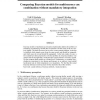Free Online Productivity Tools
i2Speak
i2Symbol
i2OCR
iTex2Img
iWeb2Print
iWeb2Shot
i2Type
iPdf2Split
iPdf2Merge
i2Bopomofo
i2Arabic
i2Style
i2Image
i2PDF
iLatex2Rtf
Sci2ools
NIPS
2007
2007
Comparing Bayesian models for multisensory cue combination without mandatory integration
Bayesian models of multisensory perception traditionally address the problem of estimating an underlying variable that is assumed to be the cause of the two sensory signals. The brain, however, has to solve a more general problem: it also has to establish which signals come from the same source and should be integrated, and which ones do not and should be segregated. In the last couple of years, a few models have been proposed to solve this problem in a Bayesian fashion. One of these has the strength that it formalizes the causal structure of sensory signals. We first compare these models on a formal level. Furthermore, we conduct a psychophysics experiment to test human performance in an auditory-visual spatial localization task in which integration is not mandatory. We find that the causal Bayesian inference model accounts for the data better than other models.
Bayesian Models | Causal Bayesian Inference | Information Technology | NIPS 2007 | Sensory Signals |
Related Content
| Added | 30 Oct 2010 |
| Updated | 30 Oct 2010 |
| Type | Conference |
| Year | 2007 |
| Where | NIPS |
| Authors | Ulrik Beierholm, Konrad P. Körding, Ladan Shams, Wei Ji Ma |
Comments (0)

